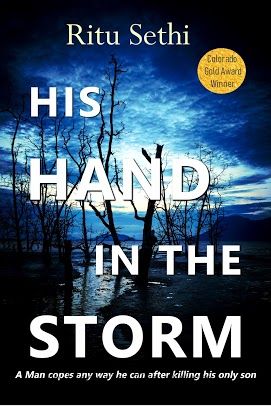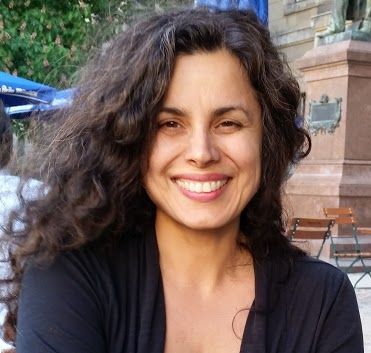
Mystery/Suspense/Thriller
Date Published: Dec 22, 2018
A MAN COPES ANY WAY HE CAN AFTER KILLING HIS ONLY SON.
His team believes he’s calm and Zen. His boss finds him obsessive. Suspects think him gorgeous but dangerous. They’re all right.
Chief Inspector Gray James is sculpting the remembered likeness of his small son when he receives the call – a faceless corpse is found hanging by the choppy river, swirls of snow and sand rolling like tumbleweeds.
Montreal glitters: the cobbled streets slippery with ice, and the mighty St. Lawrence jetting eastward past the city. One by one, someone is killing the founders of a booming medical tech startup – propelling Gray into a downward spiral that shatters his hard-earned peace, that risks his very life, that threatens to force him to care and face what he has shunned all along: his hand in the storm.
From the prize-winning author comes a psychological, page-turning mystery with all the elements one needs on a rainy night: a complex murder, a noble yet haunted detective, and an evocative setting to sink into.
Excerpt
CHAPTER 1
April 1, 5:30 am
MORE NUMBING PAIN.
At precisely five-thirty am on April the first, Chief Inspector Gray James tucked his cold hands into his pockets, straightened his spine, and looked up.
He breathed out through his nose, warm breath fogging the air as if surging out of a dragon and tried to dispel the mingled hints of flesh, cherry blossoms, and the raw, living scent of the river.
The drumming of his heart resonated deep in his chest – brought on more by intellectual excitement than by any visceral reaction to murder. Because of this, Gray accepted an atavistic personal truth.
He needed this case like he’d needed the one prior, and the one before that. That someone had to die to facilitate this objectionable fix bothered him, but he’d give audience to that later. Much later.
A car backfired on le Chemin Bord Ouest, running east-west along Montreal’s urban beach park. A second later, silence ensued, save the grievous howling of a keen eastwardly wind, and the creak of nylon against wood, back and forth, and back and forth.
Heavy boots tromping through the snow and slush came up from behind. A man approached. Tall, but not as tall as Gray, his cord pants and rumpled tweed conveyed the aura of an absent-minded professor, yet the shrewd eyes – not malicious, but not categorically beneficent either – corrected that impression.
Forensic Pathologist John Seymour looked up at the body hanging from the branch of a grand oak, gave it the eye and said, “Well, I can tell you one thing right off.”
“What’s that?”
“You wouldn’t be caught dead in that suit.”
Gray sighed. “What do you suggest? That I refer the victim to my tailor?” To which Seymour shrugged and got to work.
With every creak of the rope biting into the bough, Gray half-expected the swinging shoes to brush the snow-laden grass; each time the cap-toed oxfords narrowly missed. A grease stain marked the bony protrusion of the left white sock (with a corresponding scuff on the heel – from being dragged?), above which the crumpled brown wool-blend fabric of the pants and ill-fitting jacket rippled in the wind – like the white-tipped surface of the river beyond.
Dawn cast a blue light on the water and snow. A damp cold sank through Gray’s coat and into his bones. Amazing how the usually peaceful beach park took on a menacing air: the St. Lawrence choppier than usual, swirls of sand and snow rolling like tumbleweeds, the sky heavy and low. But a children’s playground lay behind the hanging body, and its red swings, bright yellow slide, and empty wading pool offered a marked contrast to the swaying corpse.
With every flash, Scene of Crime Officers photographed the body and documented what remained: only an exposed skull, framed by sparse hair on top, ears on either side, and a wrinkly neck puckered in a noose. A red silk tie under the hangman’s knot accentuated the complete absence of blood. Blood would have been preferable. The features were stripped to the bone, with eroded teeth set in a perpetual grin as if the skull were enjoying a joke at everyone’s expense.
“White male in his early fifties,” Seymour said. “Well off, by the look of him. Only small bits of tissue left on the cheekbones, lips, and around the eyes. Notice the distinctive gap between the two front teeth.”
That could help with identification.
The custom ringtone on Gray’s cell played “She’s Always a Woman.” Why was she calling him so soon? He stabbed the phone and tucked it back into his cashmere coat pocket before circling the body several times.
“What killed him?” Gray asked.
“The facial trauma preceded the hanging.”
That much was obvious since the rope wasn’t eaten away like the face.
“We can’t know the cause of death until I get him on the slab,” Seymour said. “And before you ask, the time of death is hard to say. Parts of him are already frozen. Maybe four to seven hours ago. I’ll have a better window after I’ve checked the stomach contents and what’s left of the eyes.”
Seymour crouched and felt the victim’s knees and lower legs. “Rigor mortis has set in, probably sped up by the cold.” He rotated the stiff ankles. “Look at these tiny feet. Can’t have been too popular with the ladies.”
Gray closed his eyes and counted to five.
All around, professionals bustled gathering evidence, clearing onlookers and photographing the scene. The park lay sandwiched between the beach and parking lot leading to the main road. On one side, the river flowed eastward in a blue-gray haze, blurring the line between water and sky. On the other, traffic going into downtown Montreal grew heavier by the minute. The road led to his neighborhood, where Victorian and Edwardian homes, bistros, and cafés crunched together for ten hipster-infused blocks.
This park held memories of weekends spent with his wife and son. A lifetime ago. Why did it have to happen here, of all places?
“Did some kind of acid cause the burns, Doctor?”
“Yeah. Parts of the eyes are still there. Almost as if they were left for last. I wonder why.”
Gray could think of a reason but didn’t elaborate.
A gust of wind swung the corpse’s legs sideways, narrowly missing an officer’s head.
“What the hell.” Seymour grabbed the ankles. “The sooner we cut him down, the better.”
Which couldn’t be soon enough. Gray bent down and held the lower legs. He gripped the ankle awkwardly with his right thumb and little finger, the middle three immobile these last three years since the accident, and a snake-like scar running from his palm to his wrist blanched from the cold.
Despite his hanging on tight, the corpse danced in the wind. “Don’t rush on my account, Doctor.”
Finally, attendants cut the victim down and laid him on a stretcher. Seymour hunched over, his blond hair parting in the breeze, revealing a pink, flaky scalp, the grinning corpse powerless to refuse examination.
“Definitely acid,” Seymour said. “Going to be hard for you to trace, since it’s so easy to get. Impure sulphuric acid’s available at any mechanic shop. You find the purer kind in pharmaceuticals.” He flashed a penlight into the facial crevices and probed them with a long, needle-like instrument.
The victim couldn’t feel it, but each stab and scrape made Gray flinch. “Must you do that?”
“Look at these chipped bones,” Seymour said. “Here, next to the supraorbital foramen, and here on the left zygomatic arch. They’re edged off, not dissolved by acid.”
“Torture, right?”
“Could be.”
Gray paced his next six words: “Was he alive for the acid?”
“I’m going to have to brush up on vitriolage. If he were, he’d have breathed it in, and we’d see scarring in the esophagus, nostrils, and lungs.”
Looking around at the flat, deserted beach park, the ropy ebb and flow of the water, Gray said, “He didn’t die here, did he?”
“No. From what I can see, livor mortis indicates he probably died sitting and was strung up later. I’ll let you know after all his clothes are off.” Seymour pushed himself up with his hands, his knees popping like the report of a firearm. “What could the poor bastard have done to deserve this?”
Gray didn’t answer. As someone guilty of the greatest sin of all, he considered himself wholly unqualified to make any such judgment.
His cell played “She’s Always a Woman,” again, and he pulled it out. Images from the previous night played in his mind: her hands flat on the mattress, his palm encircling her belly from behind. And those unexpectedly strong martinis she’d made earlier.
Putting away the phone, he spoke brusquely. “When will you have something ready?”
“Preliminary report probably later today. And I’ll send remnants of the acid for analysis to determine the type and grade.”
As the body was carried to a van and Seymour followed, second-in-command Lieutenant Vivienne Caron approached Gray carrying two cappuccinos from a nearby Italian cafe. Wonderful steam rose from the opened lids, and the dark, nutty aroma drifted forward, the first hint of comfort on this bleak morning.
Her chocolate brown eyes exuded warmth – eyes both direct and shy, their color perfectly matching her short, straight tresses now whipping about in the wind and framing gentle features.
“Chief Inspector.” She addressed him formally, despite their longstanding friendship. The sound of her nearly perfect English was pleasant and familiar, beautifully accented with the musical intonation characteristic of certain Québecois.
Even though she held the coffee before his left hand; he grasped it awkwardly with his right.
“Don’t spill any on that thousand-dollar suit,” she said.
It made him gag. “Why do you always add so much sugar?”
“Because I know that with a juicy case to solve, you’ll be too busy to eat or sleep.”
A moment of silence passed between them, pregnant with history he didn’t want exhumed.
“I have to make sure you’re okay,” she said. “Even if you refuse to... She was my best friend.”
He placed a hand on her shoulder. “You live with Sita’s ghost more than I do. Enough time has passed for me.”
“Maybe. It’s changed you.”
“For the worse?”
Vivienne stilled, her mouth open. “Non. For the better. That’s the problem.”
Her eyes were warm yet partly adversarial. He saw it as the conflicting desire for wanting him to be okay, but not to leave her to grieve alone. She’d once told him the same trauma that had disillusioned her had enlightened him.
“It doesn’t matter what happens,” he whispered.
“Doesn’t matter?” Her voice took on an edge.
“As long as you can control your reactions – it doesn’t matter. Freedom comes from living in grays – no black; no white. No convenient polarities.”
Her eyes pierced his, but he knew, out of respect, she wouldn’t directly say what she thought; that he oscillated between Zen and obsession, contentment and blackness.
She shuffled her feet. “I don’t know how you made that leap, after the tragedy.”
“The worst thing that could ever happen to me has happened. After that, I can either fear everything or nothing – I have nothing left to lose.”
Vivienne didn’t reply.
What right had he to preach when he still experienced unguarded moments which filled his insides with quicksand as that malignant though raced through his mind: what do I do now? How do I fill this day and twenty years of interminable days when everything is for nothing? When this life feels surreal, dissociated as though I’m on a foreign planet with strangers.
Those moments often occurred when he didn’t have a case; they occurred before sleep and drove his nightly obsession.
“Living in Gray?” Vivienne shook her pretty head. “I believe in good and evil.”
“Then where do I fall? Or will you make excuses for me?”
“Non. I won’t make excuses for you. “
Her eyes hooded over; she took a step back. A door slammed between them, again.
“No cell phone, no ID,” she said. “Any footprints or tracks are covered by snow.”
“Let’s have someone check with the occupants of the hospital rooms facing the river.”
Westborough Hospital sat directly across the road. A magnificent feat of engineering, its four glass-walled buildings were connected by skyways. It had taken twenty years of fundraising to build (with its founding director recently fleeing to Nicaragua under allegations of embezzling some of those funds) and took up several square blocks.
Gray forced down the coffee. Already, warmth and caffeine coursed through his system, bringing life to his numb toes tucked inside the slush-soaked loafers. “Did you check with missing persons?”
“Only one recent report matches. Norman Everett of Rosedale Avenue in Upper Westmount. He’s only been gone since last night and reported missing by his step-son, Simon Everett. And of note, Norman’s a doctor at Westborough Hospital.”
Gray’s head shot up. “Missing since last night, and works at this particular hospital? The timing’s perfect. Give me his details. I’ll do the interview myself while you finish up here.”
“D’accord.”
She handed over the number, and he made the call to Norman Everett’s house, reaching the missing man’s wife, Gabrielle.
Before Vivienne could go, a Scene of Crime Officer jumped forward and handed Gray a transparent evidence bag.
“Found this by the tree over there, Chief.”
“How recent?”
“It lay just under the snow. The city cleaned this area recently; hardly any debris around.”
Gray thanked him and looked down at the four by six-inch identity badge, examined the photo, and read the identifying details, gripping it tight enough that his fist blanched. The image blurred for the briefest second before clearing.
Vivienne rubbed her hands together. “What’s wrong?”
He didn’t trust his voice yet. A shoal of uncertainties flooded his chest. The case suddenly became more raw, more urgent, but he’d handle it. He always did. Gray unclenched his jaw and fingers, and handed her the evidence bag.
“The killer?” she asked.
“A witness.”
“Look at that ID. Look what it says. You can’t be sure.”
“Yes, I can.” His tone came out harsher than he’d intended. He could guess her next words, and he’d deserve them. Does anything matter, now? Will you be able to control your reactions? But she didn’t say it. Didn’t point out the one circumstance that sliced his calm with the efficiency of a scalpel. Instead, she met his eyes in a gentle embrace before moving farther up the beach.
Bells sounded from St. Francis, the eighteenth-century cathedral up the road for the Angelus prayer. Quebec had the largest Catholic population in the country, and maybe as a result, the lowest church attendance and marriage rate. But the familiar ringing comforted and smoothed the sharp edges of his morning.
Gray left the cordoned off area, crossed the breadth of the beach park, and headed to the attached parking lot and his car; the black metallic exterior gleamed in the distance.
At one time, the Audi S5 had consumed a substantial chunk of his detective’s salary, but he hadn’t cared. Memories of countless family road trips lay etched within its metal frame.
Still twenty feet away, he pressed the automatic start to warm the engine, just as Seymour summoned him from behind.
The doctor jogged over sporting a wry smile, breath steaming in the cold air, and his long coat flapping. Behind him, the van carrying the body left the parking lot.
“I forgot to ask you earlier – about your next expedition,” Seymour said. “Mind having some company?”
“I failed last time,” Gray said. “Or hadn’t you heard?”
“A fourteen-hundred-kilometer trek to the South Pole, on foot, is hardly a failure.”
“It is if you can’t make the journey back. Anyway–”
A boom drowned out his words. The earth shook, and air blasted towards them, throwing Gray to the ground onto his right shoulder, pain searing up his arm. Chunks of metal and debris flew from the newly obliterated Audi in every direction, denting nearby cars and clanging against the pavement. A puff of smoke shot upward, chasing the flames, leaving the smell of burning rubber and metal hanging in a thick cloud – while cars on the nearby road screeched to a sudden halt. The fire swayed as though alive, angry arms flailing and crackling, spitting sparks in all directions.
“What the hell!” Seymour lay in the snow, his mouth open, his arm up to ward off the scorching heat.
Gray’s car lay mutilated, the black paint graying as it burned. People jumped out of their vehicles to take a look. Vivienne and some officers ran towards him, their feet pounding on the asphalt.
“Someone is damn pissed off at you,” Seymour said, eying his own dented Mercedes. He turned to Gray. “What did you do?”
About the Author

A MYSTERY; A BEACH; A BEER: Ritu's favorite vacation day.
Ritu's first book, His Hand In the Storm has had nearly 50,000 downloads. It became an AMAZON BESTSELLER in the Kindle free store and was #1 in all its mystery categories. She needs coffee (her patch for Coca Cola), beaches, and murder mysteries to survive – not necessarily in that order. She won the Colorado Gold Award for the first in the Chief Inspector Gray James Murder Mystery Series, His Hand In the Storm. The book was also a Daphne du Maurier Suspense finalist.
She’s fulfilling her lifelong desire of becoming a mystery writer. Many thanks to all the readers who are making that possible.
Contact Links
Purchase Links


thanks for hosting
ReplyDelete